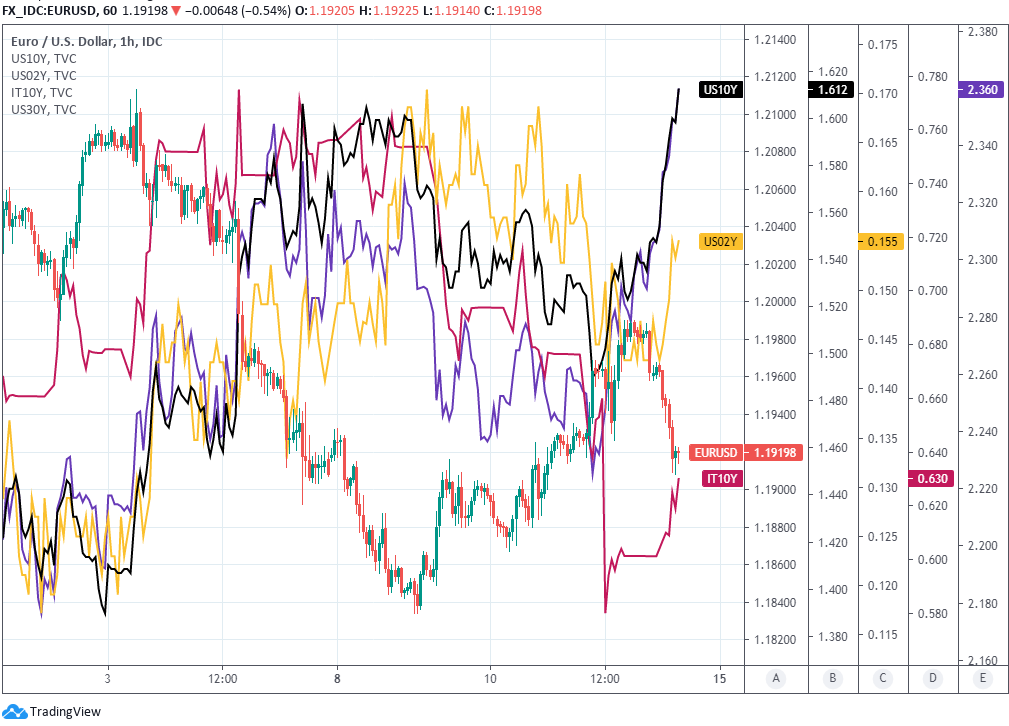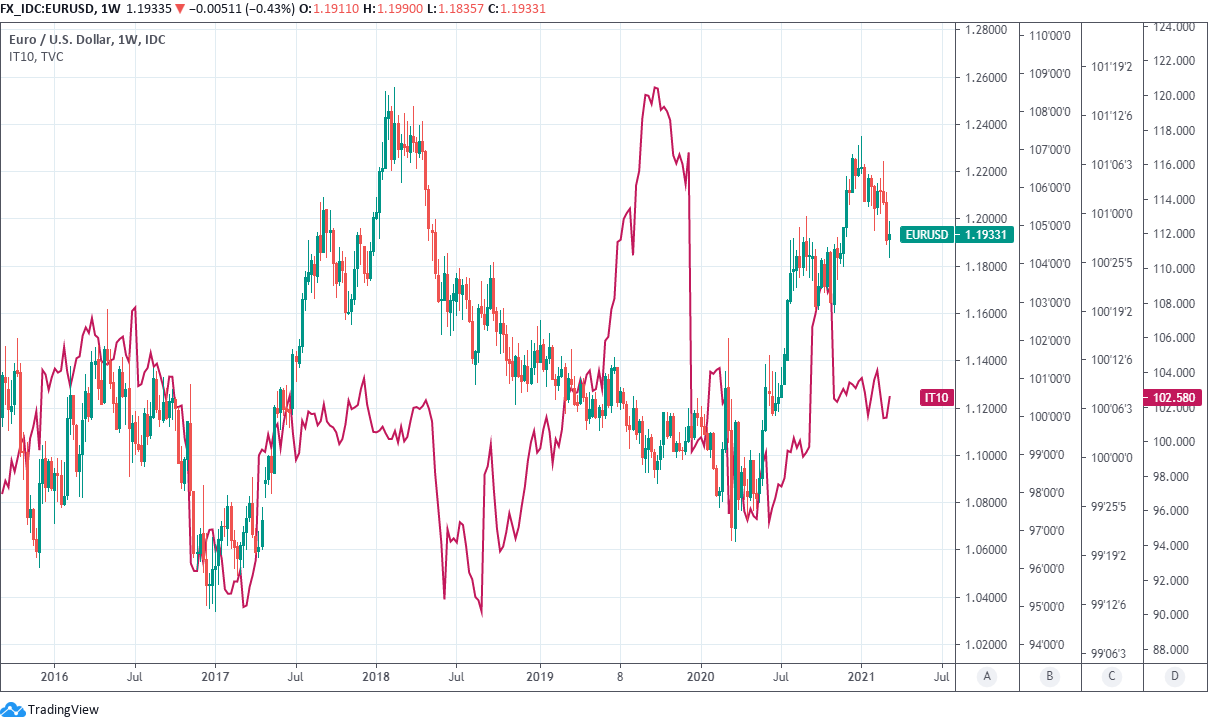Euro-Dollar Dip Buyers Circle as Bonds Baulk, U.S. Yields Hit Pandemic Highs
- Written by: James Skinner
-
- EUR/USD tumbles into weekend amid multiple headwinds.
- U.S. yields & growth outlook, EU virus developments weigh.
- But EUR/USD dip buyers circling, eye 1.20 line in the sand.

Image © European Union - European Parliament, Reproduced Under CC Licensing.
- EUR/USD spot rate at time of writing: 1.1919
- Bank transfer rate (indicative guide): 1.1516-1.1600
- FX specialist providers (indicative guide): 1.1755-1.1850
- More information on FX specialist rates here
Euro-Dollar tumbled on Fridayin a likely response to multiple headwinds, although propsective dip buyers were already waiting in the wings in anticipation of a stabilisation and recovery that is expected to unfold over the coming weeks.
Europe's single currency was back near 1.19 before slowing in its declines as the continental coronavirus situation appeared to deteriorate, with Italy headed for another national 'lockdown' through the Easter holiday and German health officials fretting about what is billed as a third wave of infections.
Meanwhile and outside of Europe, the Dollar was higher against almost all other currencies except the Brazilian Real after American bond markets sold off further, lifting longer-maturity yields to fresh pandemic highs that again appeared to upset stock markets, commodity prices and riskier currencies.
U.S. yields rose after President Joe Biden signed Washington's latest stimulus bill, which affords a total of $1.9 trillion to federal and state government programs and includes provision for more cheques of up to $1,400 for qualifying households as compensation for lost earnings during the pandemic.
"This will supercharge the new era of fiscal dominance in the US," says John Hardy, head of FX strategy at Saxo Bank. "EUR/USD needs to avoid a close above 1.2000 if the recent break lower is to retain meaning."
Big ticket spending is a negative influence on bond prices and exactly the kind of thing that can lift yields, although the packgage was approved earlier this week and had been expected for months already so its role in Friday's price action could have as much to do with Thursday's 30-year bond auction.
Above: EUR/USD at hourly intervals with 02, 10 & 30-yr U.S. yields as well as Italian (red) 10-yr yield.
The U.S. Treasury sold $24bn of 30-yr bonds with yields of up to 2.3%, their highest since February 2020, although demand was at best tepid or middling with the bid-to-cover ratio coming in at 2.3. That's around the middle of the 2.1-to-2.5 bid-to-cover range seen since the end of 2018.
Auction outcomes were a source of uncertainty this week given rising U.S. government spending, elevated inflation expectations in the financial markets and the monetary policy stance of the Federal Reserve (Fed), which has insisted it won't lift U.S. interest rates until it has actually seen some above-target inflation for an unspecified period.
"The correlation between EUR/USD and US yields, real or nominal, is insignificant over the longer term, and not that special this year," says Kit Juckes, chief FX strategist at Societe Generale. "The two G10 currency pairs most sensitive to higher Treasury yields, are USD/JPY and EUR/CHF."
{wbamp-hide start} {wbamp-hide end}{wbamp-show start}{wbamp-show end}
The auctions went smoothly, with no trouble financing the U.S. deficit, although the yield and demand outcomes illustrate and underline the apparently very limited downside to U.S. bond yields and scope for plentiful upside. Their longer-term effect on the Dollar and Euro however, is much more uncertain.
Rising yields may from time to time elicit a bid for the U.S. Dollar given they reflect some of the best returns on offer to currency market investors currently, although the entire time the pandemic goes on and the global economy remains encumbered by restrictions, rising yields will also act like what is at least a speed bump for U.S. stock markets.
Above: EUR/USD with 02, 10 & 30-yr U.S. bond prices as well as Italian (red) & German (orange) 10-yr bond price.
That's not necessarily good for the Dollar or bad for the Euro, and likewise with the European Central Bank (ECB) and its Thursday decision to bring forward quantitative easing purchases of some Eurozone bonds in order to keep financing conditions favourable. This resulted Friday in Italian and other highly indebted government bond prices proving more resilient than even their German counterparts, ensuring lesser yield rises in Europe than were seen in the U.S.
"EUR/USD has had the habit of painfully encouraging investors in on the ups and the downs within its ranges, then suddenly having a one-month trend move that has to be caught quickly – making it overall really tough to trade," says Jordan Rochester, a strategist at Nomura, who tips EUR/USD for 1.22 by June and 1.25 at year-end. "This week it seemed USD was unlikely to materially soften in the short term as there were a lack of reasons for EUR strength. But [Wednesday] we had a series of unexpected events that led us to expect a wave of more optimism in EUR/USD over the next week or so."
Rochester says ECB policy, the prospect of a summer pick-up in a so-far slovenly vaccination programme and the earlier washout of feverish speculators who'd helped drive Euro-Dollar 10% higher between April 2020 and January this year all mean the Euro could still appreciate this year.
Nomura has recommended that clients bet on a Euro move from 1.20 to 1.22 in the coming months but to do so using options, a form of derivative that can act to limit losses in the event that a trade doesn't work. The "call spread" strategy means the trade goes live upon a return to 1.20 and pays out on moves only as far as 1.22, while limiting losses to the price or "premium" paid for the options.
"As the upcoming US China talks may spark some market optimism, especially after the recent acceleration in Chinese imports from the US, we expect EUR/USD may regain some ground into next week," Rochester says. "The main risk to this trade is higher US rates, where our macro framework suggests more of a selloff this year. It’s just not so clear that after the extreme pace of rates selling off if that can be sustained into early part next week with the recent better US auctions, the FOMC meeting and US-China talks too. If the Fed revises up its dot plot and that catches the market off guard it could seriously upset the apple cart and is the risk later next week."








